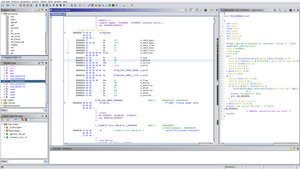Ghidra
Ghidra (pronounced Gee-druh;[3] /ˈɡiːdrə/[4]) is a free and open source reverse engineering tool developed by the National Security Agency (NSA). The binaries were released at RSA Conference in March 2019; the sources were published one month later on GitHub.[5] Ghidra is seen by many security researchers as a competitor to IDA Pro[6]. The software is written in Java using the Swing framework for the GUI. The decompiler component is written in C++. Ghidra plugins can be developed in Java or in Python (provided via Jython).[7]
 | |
 Disassembly of a file in Ghidra | |
| Original author(s) | NSA |
|---|---|
| Initial release | March 5, 2019 |
| Stable release | 9.1.2[1]
/ February 12, 2020 |
| Repository | github |
| Written in | Java, C++ |
| License | Apache License 2.0 / Public domain[2] |
| Website | ghidra-sre |
History
Ghidra's existence was originally revealed to the public via WikiLeaks in March 2017,[8] but the software itself remained unavailable until its declassification and official release two years later.[5]
In June 2019, Coreboot began to use Ghidra for its reverse engineering efforts on firmware-specific problems following the open source release of the Ghidra software suite.[9]
Supported architectures
The following architectures or binary formats are supported:[10]
- x86 16, 32 and 64 bit
- ARM and AARCH64
- PowerPC 32/64 and VLE
- MIPS 16/32/64
- MicroMIPS
- 68xxx
- Java and DEX bytecode
- PA-RISC
- PIC 12/16/17/18/24
- SPARC 32/64
- CR16C
- Z80
- 6502
- 8051
- MSP430
- AVR8, AVR32
- SuperH
See also
- IDA Pro
- JEB decompiler
References
- Ghidra 9.1.2 Release Notes
- "ghidra/NOTICE". GitHub.com. Retrieved 13 April 2019.
- "Frequently asked questions". GitHub.com. Retrieved 7 March 2019.
- "Come Get Your Free NSA Reverse Engineering Tool!". YouTube.com. Retrieved 17 May 2019.
- "The NSA Makes Ghidra, a Powerful Cybersecurity Tool, Open Source". Wired.com. Retrieved 6 March 2019.
- Cimpanu, Catalin. "NSA releases Ghidra, a free software reverse engineering toolkit". ZDNet. Retrieved 2019-03-07.
- "Three Heads are Better Than One: Mastering NSA's Ghidra Reverse Engineering Tool" (PDF). Retrieved 2019-09-30.
- "Ghidra". WikiLeaks. National Security Agency. Retrieved 22 March 2019.
- "Coreboot Project Is Leveraging NSA Software To Help With Firmware Reverse Engineering".
- "Rob Joyce on Twitter". Twitter.com. Retrieved 6 March 2019.